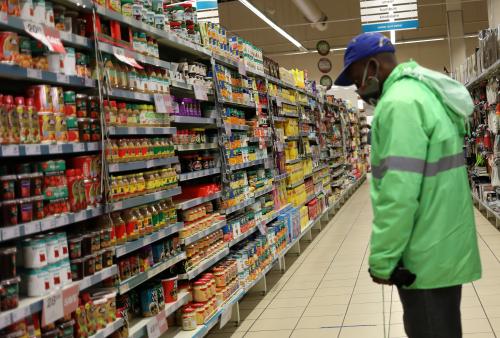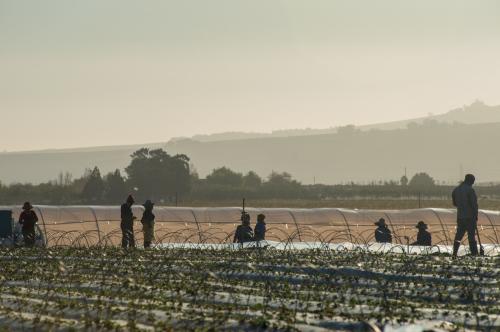Almost a year into the COVID-19 pandemic, gaps in data on how the virus is impacting African citizens both in terms of spread and household economic impacts remains scant. In an attempt to fill this gap, the World Bank recently launched a dashboard summarizing country-level results of high-frequency COVID-19 surveys conducted from April to August that asked respondents questions on 14 topics, including employment, food security, health, and others.
The surveys reveal that, with respect to employment security, people in sub-Saharan Africa have been generally less susceptible to losing their jobs, whether formal or informal, than those in other regions (except for East Asia and the Pacific) (Figure 1). In Figure 1, the World Bank’s dashboard explores whether the resilience of these jobs could stem, in part, from the structure of the region’s economies, as respondents in Africa are more likely to work on smallholder farms and in piecemeal labor. However, the location of most sub-Saharan African countries below the trendline in Figure 1 suggests that jobs in sub-Saharan Africa have been more resilient during the pandemic than their income levels would suggest.
Figure 1. Those who have lost their jobs during the pandemic by GDP per capita, sub-Saharan Africa vs. other regions
Source: World Bank. “COVID-19 High-Frequency Monitoring Dashboard.”
At the same time, households in some sub-Saharan African nations reported being food insecure across multiple dimensions (Figure 2). In all countries surveyed in the region, at least 45 percent of households reported being worried about running out of food in the last 30 days. In South Sudan, 72 percent of households reported going an entire day without eating in the last 30 days due to a lack of money. In Nigeria, 3 in 4 households reported skipping a meal in the previous 30 days due to a lack of money. Just under two in three households in Malawi reported being hungry but not eating in the last 30 days because of a lack of funds. These data points show the potentially destructive effects of the pandemic, along with other events like the locust plague of East Africa earlier this year, can have on food security by virtue of disrupted supply chains and the subsequent rise in prices. In contrast to these dynamics, however, other surveys revealed African countries in which food insecurity is not as salient a problem. For example, in a July survey, only 1.9 percent of households in Mali reported that a lack of money caused them to go a whole day without eating in the last 30 days.
Figure 2. Measures of food security (percentage of households answering affirmatively)
Source: World Bank. “COVID-19 High-Frequency Monitoring Dashboard.”
The surveys also reveal that households across the continent are turning to a number of different methods to cope with job loss and income shocks. For example, more than 86 percent of respondents in the DRC reported reducing consumption (of essential or nonessential goods) during the pandemic. Just under half the households interviewed in Ghana reported using emergency savings to cover basic living expenses during the pandemic. Despite the tendency for economic shocks to limit access to services like health care, however, a large majority of households across the continent reported that they received medical attention when they needed it, as depicted in Figure 2. Every country surveyed, with the exception of the Central African Republic at 27 percent, had shares of at least 75 percent. In Burkina Faso, 98 percent of respondents reported that they still were able to receive medical attention when they needed it.
Figure 3. Share of households that received medical attention when needed, sub-Saharan Africa
Source: World Bank. “COVID-19 High-Frequency Monitoring Dashboard.”
To read about South Africa’s attempts to soften the impact of the pandemic, read “Lockdown economics in South Africa: Social assistance and the Ramaphosa stimulus package.” For more information on how the pandemic has affected household livelihoods, check out “Figures of the week: The effect of COVID-19 on food and income security in Africa.”
The Brookings Institution is committed to quality, independence, and impact.
We are supported by a diverse array of funders. In line with our values and policies, each Brookings publication represents the sole views of its author(s).









Commentary
Figure of the week: Sub-Saharan Africa shows resilience to the effects of COVID-19, according to high-frequency phone surveys
December 11, 2020